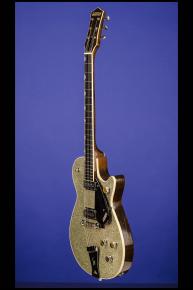An All Original and Exceptionally Fine and Rare Transitional Early 1958 Gretsch 6129 Silver Jet
1958 Gretsch 6129 Silver Sparkle.
This very early 1958, featherweight 13 1/4-inch-wide guitar weighs just 7.40 lbs. and features a four-ply white and black bound chambered mahogany body with a pressed arched top of silver sparkle plastic laminate. One-piece mahogany neck (no heel-dowel) with a nice, fat nut width of just over 1 11/16 inches, a scale length of 24 3/4 inches and a wonderful fat profile. Bound Ebony fretboard with 22 original medium-thin frets and inlaid pearloid 'Neo-Classic' half-moon position markers. Single-bound headstock with laminated dark maple face and inlaid pearl Gretsch "T-roof" logo. Individual Grover StaTite open-back tuners with oval metal buttons. Two single-coil DeArmond Dynasonic pickups with outputs of 3.02k and 3.00k. Original black and white plastic pickup rings. Black lucite pickguard with Gretsch "T-roof" logo engraved in white from the underside. Four controls (two volume and one tone on the lower treble bout and one master volume control on the treble horn), plus a three-way pickup selector switch on upper bass bout. The pots are stamped "134 640" (Centralab, October 1956). "Arrow-through-G" chrome-plated brass control knobs with cross-hatch pattern on sides. Space-control bridge with six adjustable saddles on ebony base and chrome cut-out "G-hole flat" tailpiece. The serial number "27289" printed on a label inside the control cavity with the model number "6129." The serial number is also engraved on the outside of the control cavity cover. This is one of the rarest Silver Jets, with this one being a transition model, still with the DeArmond pickups but now with an Ebony fretboard with Neo-Classic pearl half-moon position markers and a 'Space-Control' bridge. The guitar is 100% original with the exception of the "D" tuner bushing which has been replaced with an almost identical but slightly deeper version. There is some minor belt buckle wear on the back (nothing through the finish), some slight edge wear to the bottom of the body, a few small marks/indentations on the sides of the body and the back of the neck. There is a very small piece (3/16 inch) missing from the binding on the bass side of the headstock by the nut and a small piece chipped away from the maple laminate on the headstock just below the "B" tuner. There is no shrinkage of the body binding and the silver sparkle top is exceptionally bright. One of the best looking, playing, and sounding DeArmond Silver Jets that we have seen. Included in the case is the original four-page green card Gretsch Quality Control "O.K.Card" hang-tag with matching serial number, the original Gretsch Neo-Classic Fingerboard card, the original Gretsch 'Space Control Bridge' card, the original "Bobby Lee 'No-Mishap' black leather guitar strap complete with the original instruction sheet, and to top it all - the original? used strings in the circular plastic Gretsch case… Housed in the original two-tone gray hardshell case with maroon plush lining (9.00).
According to Ed Ball the early 1958 272XX run was of one hundred "Jet solidbodies - including Cadillac Green examples. The earliest 1958 Jets had pot codes of October 1956 (same as our guitar). The later examples in the run had pot codes of February and April 1957.
"In the 1958 model year, the Melita bridge was swapped out of the Jet solidbody models for the internally manufactured Space Control (floating) bridge. At the same time, the fretboard inlay was upgraded to the new neoclassic style (a.k.a. thumbnail) on an ebony fretboard. Inexplicably, as most of the 1958 Gretsch electric guitar product line was receiving the new Filter'Tron (humbucking) pickup technology, the Jet solidbodies did not. As a result, this late to arrive feature is, in fact, a 1959 model year indicator for the Jet solidbody guitars." (Edward Ball. Ball's Manual of Gretsch Guitars 1950s, p. 69).
"In 1953 Gretsch launched its first solidbody, the single-cutaway Duo Jet. In fact, the guitar was a semi-solid with routed channels and pockets inside, but the visual effect was certainly of a solidbody instrument. In its early years the new Duo Jet had, unusually, a body front covered in a black plastic material, as used on some Gretsch drums. It also had Gretsch's unique two-piece strap buttons (an early take on the idea of locking strap buttons) and the Melita Synchro-Sonic Bridge" (Tony Bacon, Electric Guitars: The Illustrated Encyclopedia, pp. 163-165).
"1957 was an enigmatic year for the Jets. For most of that year they were issued with pearloid plastic humped-back inlays in their Brazilian rosewood fingerboards. If a Jet has this style position-marker it was made in 1957. At the very end of the year, however, Silver Jets, Duo Jets and Jet Firebirds appear with the new-for-1958 ebony neo-classic fingerboard with half-moon inserts (thumb print inlays) and, it seems, were intended to be included in, and what should be considered to be products of, model year 1958. On very rare occasion, these transition Jets have another 1958 feature, the space control bridge, instead of a Melita. The presence of a heel-dowel would insure that the guitar was produced in 1958, of course. 1957 Models 6128, 6129 and 6131 use brass, chrome-plated "G" -indent control knobs with an impressed block letter "G" pierced by an arrow to replace the previous year's arrow knobs." (Jay Scott. The Guitars of the Fred Gretsch Company, p. 95).

















